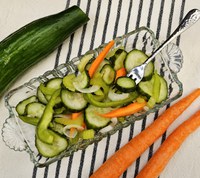Prairie Fare: Preserve food and memories
(Click an image below to view a high-resolution image that can be downloaded)
Recently I was helping clean out the home of someone who had passed away. I came upon a jar of home-canned jelly in a cupboard. I could tell the jar had been there a while because the jar had a layer of dust.
I pulled the jar from the cupboard shelf and turned it around to see the date. The label had yellowed, but I could read the printing.
The label said “1987.” The contents were 36 years old. Unfortunately, canned jelly is not like fine wine, which tends to get better with age.
I am guessing the jelly was prepared by a relative and probably had sentimental value.
What happens when jelly sits for decades in a jar on a shelf? My scientific instincts kicked in and I flipped the jar upside down. The darkened jelly did not move even when I shook the jar gently. Even though I enjoy a science experiment, I did not open the jar.
I threw away the filled jar of jelly, even though canning jars can be used indefinitely. I am not sure I would have been able to pry the jelly from the jar.
I wondered about the history of the canned jelly. Had it been made by a grandparent, aunt or uncle who had passed away?
Through the years, I have had many questions from people who are cleaning out estates. Sometimes the canned goods are of “museum quality,” and I find myself giving “permission to toss.” We do not want to eat antique canned goods whether they are homemade or from a store.
You could serve recently prepared food in your grandma’s glass container, though.
Canned goods do not last forever, so be sure to check the dates on foods periodically. Arrange your cupboards on a first-in, first-out basis so you use the oldest food first.
Commercially canned vegetables, such as cans of green beans, retain their quality on your shelf for up to five years, according to the U.S. Department of Agriculture. Commercially canned acidic foods, such as tomatoes and fruit, retain their quality for 18 months.
We put a shorter shelf life on home-canned goods. We advise using home-canned goods within a year of canning for best quality, although they will remain safe longer.
Jellies and pickled foods are a good place to start when delving into home food preservation. For safety and quality, use tested recipes.
Pickled and fermented foods have become popular. In some restaurants, a side dish or garnish of fresh pickles adds some novelty to your plate and a nice kick of acidity.
Pickling and fermentation as food preservation methods have a long history. Along with drying, pickling was one of the early forms of preserving food during times when people didn’t have refrigerators, freezers or any of the modern conveniences we have.
The term “pickle” is derived from the Dutch word “pekel” meaning “to salt or brine.”
Pickles can be fermented in a salty brine, where naturally present lacto-bacteria produce lactic acid and the characteristic flavor and texture. Most pickles today are made using vinegar of a prescribed acidity level (5%).
You might have pickling recipes from your ancestry. Some heritage recipes meet today’s safety standards while others do not. Be sure to compare heritage recipes to modern research-tested versions. If they are written in your grandma’s handwriting but do not meet today’s safety standards, frame the recipe and display it, but don’t make it.
Some of the vegetables and fruits we grow today are different chemically (less acidic, for example) than older varieties of vegetables. Old recipes will not necessarily be safe to use.
See www.ag.ndsu.edu/food for many tested recipes for pickles, salsa, jams, jellies, along with information about freezing, drying and pressure canning vegetables.
Fresh Refrigerator Pickles (Not for canning)
1 cup carrots, sticks or coins, whatever you prefer
1 cup sliced onions
4 stalks celery, sliced
7 cups cucumbers, sliced into coins
1 large green bell pepper, sliced into strips
Brine
1 cup sugar
2 cups vinegar
2 cups water
2 tablespoons canning salt
Rinse and cut vegetables. In a large bowl, mix the vegetables together. Pour brine over vegetables and mix again. Pack vegetables into jars with brine; all vegetables should be submerged in brine. Keep in the refrigerator. For best flavor, let vegetables sit in brine for at least eight hours before serving. Refrigerator pickles are safe for about a month, but discard them if they get moldy or show other signs of spoilage.
Makes eight (½-cup) servings. Nutrition information is not available.
(Julie Garden-Robinson, Ph.D., R.D., L.R.D., is a North Dakota State University Extension food and nutrition specialist and professor in the Department of Health, Nutrition and Exercise Sciences. Follow her on Twitter @jgardenrobinson)
NDSU Agriculture Communication – June 29, 2023
Source: Julie Garden-Robinson, 701-231-7187, julie.garden-robinson@ndsu.edu
Editor: Elizabeth Cronin, 701-231-7881, elizabeth.cronin@ndsu.edu




